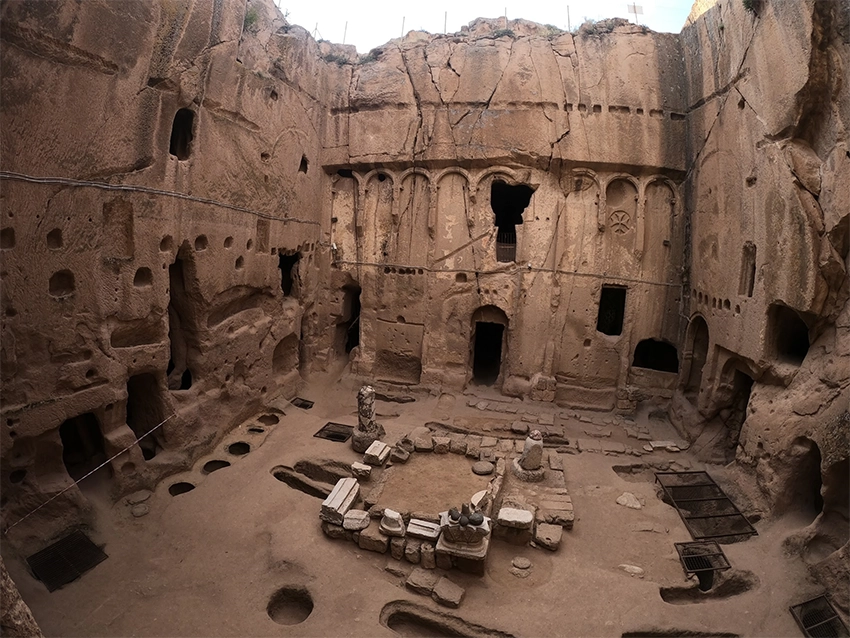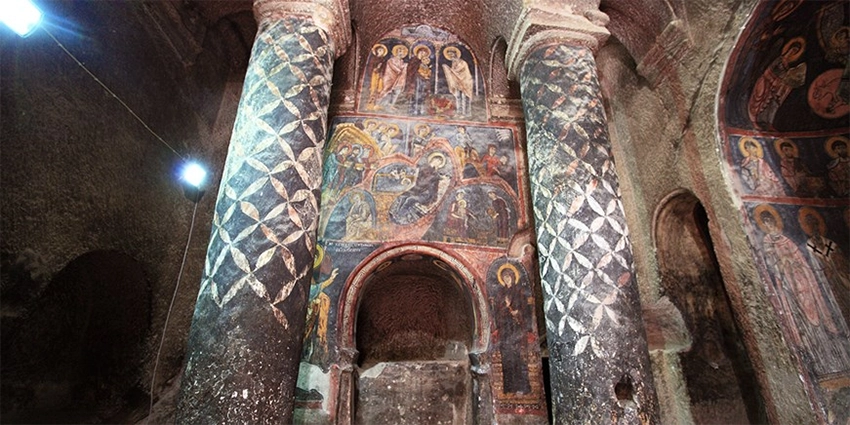Gumusler Monastery
Gümüşler Monastery (Niğde) – Cappadocia’s Spiritual Heritage Carved in Rock
History and Significance
Located just 8 km from Niğde town center, in the village of Gümüşler, this rock-carved monastery is one of the most important Middle Byzantine monuments in Cappadocia. Built between the 8th and 12th centuries, it stands out for both its architecture and frescoes.

The settlement was known as Traikas (Dragia) in Byzantine times. Later, during the Ottoman era, it took the name “Gümüşler” from the nearby silver mines. Abandoned after the 1924 population exchange, it remained forgotten for 40 years until rediscovery in 1962. Restoration began under British archaeologist Michael Gough in 1963, and in 1973 it was designated a protected site and opened to visitors.
The monastery is also popularly known as the “Smiling Virgin Monastery”, due to its unique fresco of the Virgin Mary with a gentle smile the only known example of its kind in Anatolia.
Architecture and Layout
The complex is carved entirely into a massive block of tuff rock, with a large open courtyard at its center (15 meters in diameter and 14 meters deep). Around the courtyard are:
- Monk cells
- Kitchen and storage rooms
- A wine press
- The main church
This symmetrical, organized plan sets it apart from other Cappadocian monasteries.
The Church
The church is one of the rare examples in Cappadocia with a closed Greek-cross plan. Four rock-cut pillars support a central dome, with four arms extending from it. There are three apses, and the western façade features a barrel-vaulted narthex with two entrances. Above the narthex lies a chamber containing rare frescoes.
Frescoes and Artistic Value
The frescoes date to the 10th century and are believed to be the work of three different painters:
- Main apse dome: Christ Pantocrator enthroned, surrounded by angels and the symbols of the Evangelists
- Below: A Deesis scene with Christ, the Virgin Mary, and John the Baptist
- Lower register: Portraits of the Cappadocian Fathers St. Basil of Caesarea, St. Gregory of Nyssa, and St. Gregory of Nazianzus
- North arm of the cross: Annunciation, Nativity, Presentation at the Temple, Baptism, and depictions of saints such as Stephen and John the Baptist

Differences in style confirm multiple artists worked here.
The “Smiling Virgin” Fresco
The most famous fresco of Gümüşler is located beside the entrance of the narthex. The Virgin Mary sits enthroned with the Child Christ, flanked by Archangels Gabriel and Michael. What makes it extraordinary is Mary’s gentle smile unique in Anatolian fresco tradition and a defining image of the monastery.
Unique Hunting Scenes
Unusually, the chamber above the narthex features hunting and animal scenes, absent in other Cappadocian churches. These may be inspired by Aesop’s fables or local folklore. One fresco shows a fox trying to reach grape clusters, reminiscent of “The Fox and the Grapes.” Such secular imagery reflects the artistic freedom that emerged after the Iconoclast period.
Underground Structures
Beneath the eastern side of the rock block lies a 1.5 km-long underground settlement. Spread across two levels, it includes:
- Stables
- Food storage rooms
- Secret passages
These were designed for monastic refuge and defense. Parts of this underground system remain accessible today.
Visitor Information
- Location: 8 km from Niğde center, in Gümüşler village
- Transport: Easily accessible by private car; local minibuses also pass nearby
- Opening Hours: Summer: 08:30 – 19:00 | Winter: 08:30 – 17:00. Ticket office closes ~45 minutes earlier
- Tickets: Museum Pass valid; check Niğde Directorate of Culture and Tourism for updated prices
Tips for Visitors:
- The courtyard is open-air bring a hat and water in summer
- Interiors are dim carry a flashlight or LED light
- Flash photography is prohibited
- Use tripod or phone support for clear shots of frescoes
Photo Highlights:
- Look up from the courtyard to frame the sky within the circular rock walls
- Long-exposure works best for the Smiling Virgin fresco
- Ask staff if the upper hunting-chamber is accessible
Experience
Gümüşler Monastery offers not only a glimpse of Byzantine spirituality but also a fascinating blend of art, folklore, and monastic life. Its frescoes, unique architecture, and the famous Smiling Virgin make it one of the most captivating religious monuments in Cappadocia and beyond.



